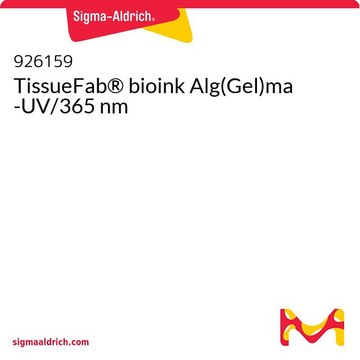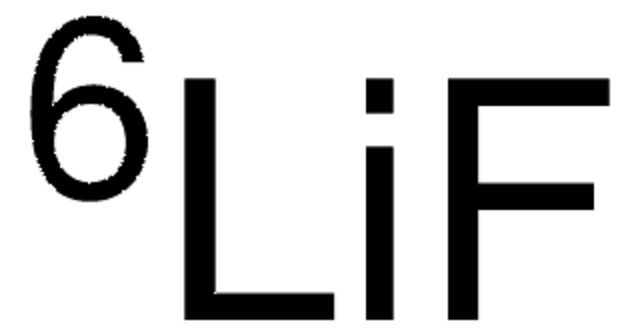925055
TissueFab® GelAlg − LAP Bioink
low endotoxin, 0.2 μm filtered, suitable for 3D bioprinting applications
Sinonimo/i:
GelMA-alginate bioink
Autenticatiper visualizzare i prezzi riservati alla tua organizzazione & contrattuali
About This Item
Codice UNSPSC:
12352201
NACRES:
NA.23
Prodotti consigliati
Livello qualitativo
Sterilità
0.2 μm filtered
Stato
viscous liquid (gel)
Impurezze
<5 cfu/mL Bioburden
<50 EU/mL Endotoxin
Colore
pale yellow to colorless
pH
6.5-7.5
Viscosità
10-40 cP
applicazioni
3D bioprinting
Temperatura di conservazione
2-8°C
Categorie correlate
Descrizione generale
Gelatin methacryloyl (GelMA) is a polymerizable hydrogel material derived from natural extracellular matrix (ECM) components. Due to its low cost, abundance, and retention of natural cell-binding motifs, gelatin has become a highly sought material for tissue engineering applications.
Alginate is a naturally occurring polymer widely applied for bioprinting applications as its printability can be easily modified by altering the polymer density and crosslinking with the addition of calcium chloride (CaCl2). Alginate is often combined with gelatin to facilitate cell adhesion and differentiation.
Temporal and spatial control of the crosslinking reaction can be obtained by adjusting the degree of functionalization and polymerization conditions, allowing for the fabrication of hydrogels with unique patterns, 3D structures, and morphologies.
Alginate is a naturally occurring polymer widely applied for bioprinting applications as its printability can be easily modified by altering the polymer density and crosslinking with the addition of calcium chloride (CaCl2). Alginate is often combined with gelatin to facilitate cell adhesion and differentiation.
Temporal and spatial control of the crosslinking reaction can be obtained by adjusting the degree of functionalization and polymerization conditions, allowing for the fabrication of hydrogels with unique patterns, 3D structures, and morphologies.
Applicazioni
Gelatin methacrylate based bioinks have been used in the following bioprinting applications:
- osteogenic [1],
- chondrogenic [2] [3],
- hepatic [4] [5] [6],
- adipogenic [7],
- vasculogenic [8],
- epithelial [6],
- endothelial [9] [10],
- cardiac valve [11],
- skin [12],
- tumors [10]
Caratteristiche e vantaggi
- Ready-to-use formulation optimized for high printing fidelity and cell viability, eliminating the lengthy bioink formulation development process
- Step-by-step protocols developed and tested by MilliporeSigma 3D Bioprinting Scientists, no prior 3D bioprinting experience needed
- Suitable for different extrusion-based 3D bioprinter model
- Methacrylamide functional group can also be used to control the hydrogel physical parameters such as pore size, degradation rate, and swell ratio.
Note legali
TISSUEFAB is a registered trademark of Merck KGaA, Darmstadt, Germany
Codice della classe di stoccaggio
10 - Combustible liquids
Classe di pericolosità dell'acqua (WGK)
WGK 3
Scegli una delle versioni più recenti:
Certificati d'analisi (COA)
Lot/Batch Number
It looks like we've run into a problem, but you can still download Certificates of Analysis from our Documenti section.
Se ti serve aiuto, non esitare a contattarci Servizio Clienti
Possiedi già questo prodotto?
I documenti relativi ai prodotti acquistati recentemente sono disponibili nell’Archivio dei documenti.
Liliang Ouyang et al.
Biofabrication, 8(3), 035020-035020 (2016-09-17)
3D cell printing is an emerging technology for fabricating complex cell-laden constructs with precise and pre-designed geometry, structure and composition to overcome the limitations of 2D cell culture and conventional tissue engineering scaffold technology. This technology enables spatial manipulation of
Wanjun Liu et al.
Advanced healthcare materials, 6(12) (2017-05-04)
Bioprinting is an emerging technique for the fabrication of 3D cell-laden constructs. However, the progress for generating a 3D complex physiological microenvironment has been hampered by a lack of advanced cell-responsive bioinks that enable bioprinting with high structural fidelity, particularly
B Duan et al.
Acta biomaterialia, 10(5), 1836-1846 (2013-12-18)
Tissue engineering has great potential to provide a functional de novo living valve replacement, capable of integration with host tissue and growth. Among various valve conduit fabrication techniques, three-dimensional (3-D) bioprinting enables deposition of cells and hydrogels into 3-D constructs
Methacrylated gelatin and mature adipocytes are promising components for adipose tissue engineering.
Birgit Huber et al.
Journal of biomaterials applications, 30(6), 699-710 (2015-05-29)
In vitro engineering of autologous fatty tissue constructs is still a major challenge for the treatment of congenital deformities, tumor resections or high-graded burns. In this study, we evaluated the suitability of photo-crosslinkable methacrylated gelatin (GM) and mature adipocytes as components
Wanjun Liu et al.
Biofabrication, 10(2), 024102-024102 (2017-11-28)
Bioinks with shear-thinning/rapid solidification properties and strong mechanics are usually needed for the bioprinting of three-dimensional (3D) cell-laden constructs. As such, it remains challenging to generate soft constructs from bioinks at low concentrations that are favorable for cellular activities. Herein
Il team dei nostri ricercatori vanta grande esperienza in tutte le aree della ricerca quali Life Science, scienza dei materiali, sintesi chimica, cromatografia, discipline analitiche, ecc..
Contatta l'Assistenza Tecnica.








